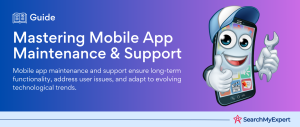Want to make your app stand out? Ratings and reviews play a big role. A jump from three to four stars can skyrocket conversions by almost 89%. Let’s understand why they matter and how you can improve them.
What Are App Ratings and Reviews?
In simple terms, these are the stars (from one to five) and comments users leave on the App Store or Google Play Store. A higher average means more users like your app. It’s not just about first impressions. Good ratings and reviews also help with App Store Optimization (ASO) – making your app easier to find and download.
What’s a Good Rating?
An app with four stars or more is doing great. But, more reviews can make a big difference. Even if your app has five stars, if it only has a few reviews, it might not seem trustworthy. But, an app with hundreds of 4.5-star reviews looks better.
Why Do Ratings Matter?
1. Better Visibility:
High ratings make your app shine in search results. More stars mean more clicks.
2. Trust Building:
Good reviews make users trust your app more. Bad reviews can push them away.
3. Higher Downloads:
When users see many positive reviews, they’re more likely to download your app.
4. More Money:
More positive reviews can mean more downloads and more chances to earn money, either through ads, in-app purchases, or other methods.
5. Connect with Users:
Reviews let users share feedback. You can respond and make your app even better.
Apple App Store vs. Google Play Store
Both these platforms have different ways of managing ratings and reviews:
- Apple App Store: Every rating counts. If you update your app, you can start fresh with ratings.
- Google Play Store: Doesn’t focus on lifetime ratings. It gives more weight to recent ratings. So, if your app gets better, your ratings can improve faster.
How to Get Better Ratings?
1. Focus on Quality:
Make sure your app works well and offers what users want.
2. Ask Nicely:
More ratings can stabilize your app’s average score. So, ask your users to rate your app.
3. Update Regularly:
Listen to feedback and keep improving. When users see you care, they’re likely to rate better.
In short, focus on user satisfaction, listen to feedback, and keep updating your app. Great ratings and reviews will follow!
Responding to Reviews
Engaging with users who leave reviews is a smart move, whether they’re positive or negative. Here’s why:
1. Builds Trust:
When users see developers responding to feedback, it shows commitment and care.
2. Gather Insights:
By directly communicating with users, you get a deeper understanding of their needs and issues.
3. Turn Negatives to Positives:
Addressing concerns and fixing reported issues can often make a disappointed user change their initial negative rating.
Encourage Feedback Inside Your App
A proactive way to gather more reviews is to create a feedback loop within your app:
1. In-App Prompts:
Gently remind users to leave a rating or review after they’ve used your app for some time.
2. Easy Feedback Channels:
Have a simple way for users to send feedback or report issues. This can prevent negative reviews, as users will communicate directly with you first.
3. Reward Reviews:
Some apps offer small incentives, like in-app rewards, for leaving a review. It’s a little nudge that can lead to more feedback.
App Store Optimization (ASO) and Reviews
ASO is all about making your app more visible. While keywords, app title, and description play a part, reviews are crucial too:
1. Keyword Boost:
On platforms like Google Play, user reviews contribute to keyword indexing. That means, if users mention certain features or benefits in their reviews, it can help your app’s searchability.
2. Freshness Factor:
Regularly updated apps with recent reviews can rank higher. It shows the app is active and maintained.
Monitoring and Managing Reviews
Keeping a close eye on your reviews and actively managing them can be the game-changer in your app’s success.
1. Use Analytics Tools:
There are several tools available that provide insights into your app’s reviews. They can alert you when negative reviews appear or when a surge in feedback happens, ensuring you’re always in the know.
2. Consistent Check-ins:
Allocate time weekly, or even daily, to check on new reviews. This consistency ensures no feedback falls through the cracks.
3. Team Involvement:
Ensure that both your development and customer service teams have access to user feedback. This can aid in faster issue resolution and better feature planning.
Cultivating a Positive App Community
Beyond reviews, fostering a supportive user community can lead to even stronger trust and loyalty.
1. Engage on Social Media:
Platforms like Twitter, Facebook, and Instagram offer additional channels to communicate with users, gather feedback, and showcase your app’s features.
2. Feature User Testimonials:
Highlighting positive user stories or case studies on your app’s website or store page can sway potential users.
3. Beta Testing Groups:
Before rolling out new features, consider having a group of dedicated beta testers. Their feedback can be invaluable, ensuring the wider user base gets a smoother experience.
Stay Updated with Market Trends
The app ecosystem is dynamic, with user preferences and technology constantly evolving.
1. Competitor Analysis:
Regularly check out top-performing apps in your category. Understand what they’re doing right and where they might be lacking.
2. Attend Webinars and Workshops:
Stay updated with the latest in app development, ASO, and user engagement strategies by joining industry webinars or workshops.
3. User Surveys:
Periodically, send out surveys to your user base. Direct questions about potential features, UI/UX changes, or general feedback can guide your development roadmap.
Handling Negative Feedback
While we all desire positive reviews, negative feedback is inevitable. However, it’s not the end of the world; rather, it’s an opportunity.
1. Stay Professional:
Responding defensively can escalate the situation. Always approach negative comments with understanding and a solution-oriented mindset.
2. Acknowledge and Apologize:
Recognizing a user’s concern and genuinely apologizing can go a long way in mending relationships.
3. Act Quickly:
If the feedback points to a specific problem, address it promptly. Then, let the user know it’s been fixed.
Strategies for Continuous Improvement
Your app’s growth and user satisfaction are ongoing journeys.
1. Iterative Testing:
A/B testing of features, designs, or even app descriptions can give insights into user preferences.
2. Stay User-Centric:
Always prioritize user needs. Regular feedback sessions, user group discussions, or interactive webinars can be beneficial.
3. Leverage Technology:
With the emergence of AI and ML, predictive analytics can help foresee user behavior and preferences, allowing you to be a step ahead.
Promote Positive Behavior
Encouraging users to leave positive feedback isn’t manipulative; it’s about guiding satisfied users to voice their contentment.
1. In-App Achievements:
Reward users for leaving feedback or achieving certain milestones within the app.
2. Feedback Reminders:
A gentle reminder post a successful task or level completion can prompt users to leave positive reviews.
3. Community Building:
Create forums or groups where users can share their experiences, tips, and tricks. Peer-to-peer positivity can lead to more organic reviews.
Expanding Beyond Reviews
While ratings and reviews are crucial, think holistically about user engagement.
1. Referral Programs:
Happy users can bring more users. Introduce referral bonuses or rewards.
2. Interactive Content:
Host webinars, create tutorial videos, or write blogs about features. It enhances user engagement and education.
3. Partnerships and Collaborations:
Collaborate with complementary apps or influencers to reach a broader audience.
Beyond The App Store: Building Brand Presence
While your app’s performance in the store is crucial, its presence outside of it can heavily influence user perceptions and downloads.
1. Leverage Social Media:
Having active profiles on platforms like Instagram, LinkedIn, and Twitter can boost brand awareness. Regular updates, behind-the-scenes looks, and user stories can engage a broader audience.
2. Engaging Content Creation:
Start a blog related to your app’s niche. Topics could range from industry trends, how-to guides, or user success stories. This not only positions your brand as an authority but can also improve organic search traffic.
3. Email Campaigns:
Keep your users engaged with regular newsletters. Highlight new features, share user testimonials, or offer special promotions.
Networking & Collaboration
Building relationships within the industry can significantly propel your app’s success.
1. Attend Conferences:
Engaging in industry-specific events can help you gain insights, meet potential partners, and learn from successful peers.
2. Guest Blogging:
Write for industry-relevant websites or blogs. This widens your reach and establishes credibility.
3. Collaborate with Influencers:
Identify influencers in your app’s domain and partner for promotional activities. Their endorsement can drive significant user traffic.
User Retention Strategies
Attracting users is essential, but retaining them ensures long-term success.
1. Loyalty Programs:
Introduce schemes where long-term users or frequent users get exclusive features or rewards.
2. User Feedback Loops:
Periodically engage with users to understand their evolving needs and iterate your app accordingly.
3. Seamless Experience:
Ensure your app remains bug-free, user-friendly, and continues to offer value, ensuring users keep coming back.
Continuous Learning and Upgradation
Stay ahead of the curve by continuously updating your knowledge and skills.
1. Online Courses:
Platforms like Coursera or Udemy offer numerous courses on app development, marketing, and user engagement.
2. User Behavior Analysis:
Use tools to track how users interact with your app. Understanding their behavior can lead to valuable feature additions or changes.
3. Adapt to Trends:
The digital landscape is ever-evolving. Whether it’s a new design trend, a technology, or a marketing strategy, staying updated ensures your app remains relevant.
The below flowchart maps the app’s journey from its initial development to the continuous learning and upgradation, emphasizing feedback’s role in the process:

Conclusion
In the realm of app development, understanding and valuing user feedback is paramount. By integrating user feedback into your growth strategy, not only will your app’s ratings soar, but you’ll foster an environment of trust, loyalty, and shared growth. Your users are your greatest asset; treasure their voice, and they’ll champion your success. The journey of an app isn’t just about its creation but its growth and evolution, driven by continuous user engagement and feedback. As you progress, remember that each user’s voice matters, and each interaction is an opportunity. By expanding your horizons beyond the app store and investing in holistic growth strategies, your app can reach heights previously unimagined.
Searching for elite Mobile App Developers? Look no further.
Table of Contents
Toggle






